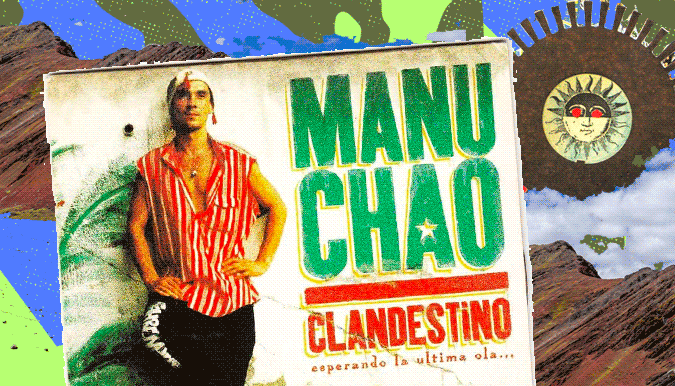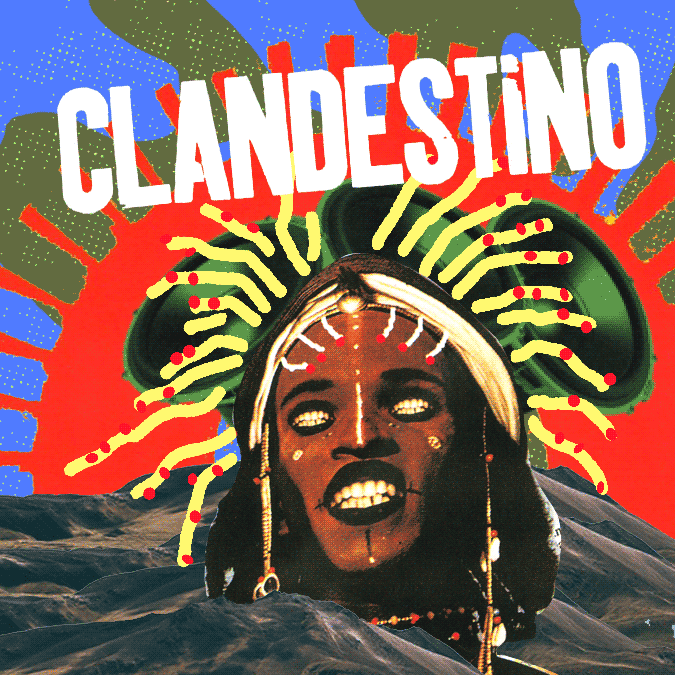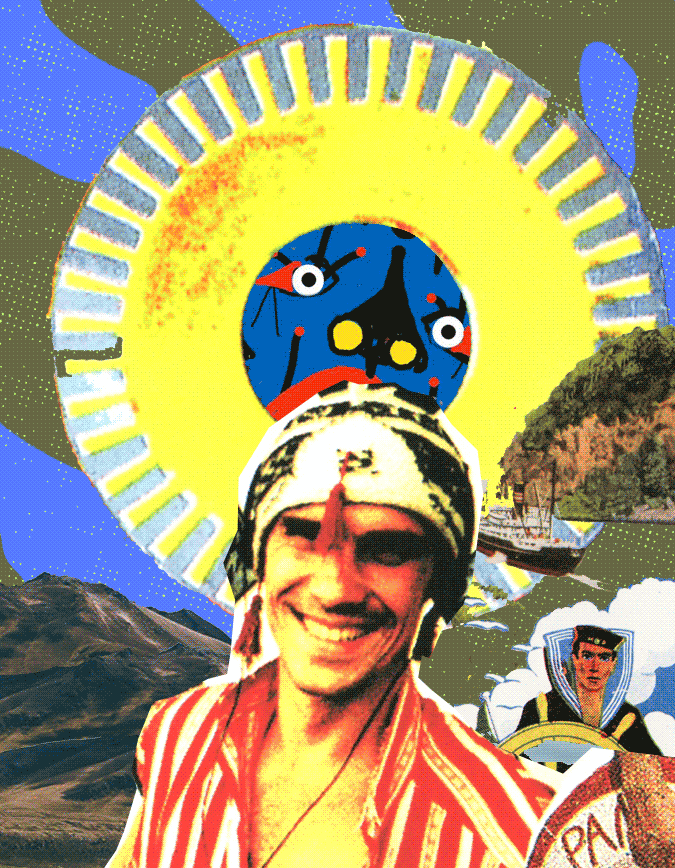José-Manuel Thomas Arthur Chao Ortega is perhaps France’s most successful rock musician of all time, not to mention an inimitable icon of rock en español. Yet he probably feels more comfortable being labeled a busker: a musician in the street playing his heart out, observing his surroundings, and making songs about it. He’s known to pop up on the sidewalk next to any given bar of any given city he happens to be in at the moment and start playing. Busking is what taught Manu Chao about the universality of music, and it informs Clandestino, his debut solo album. The project turns 20 this year, and remains perhaps his boldest statement yet.
There’s nothing conventional about Clandestino, yet its radicalism relies on humanist values. Although his former band Mano Negra was at one point one of the most popular musical groups in France, Manu renounced the country as his own, disappearing on the road and appearing throughout Mexico, South America, Europe or Africa, something that allowed him to reach audiences beyond traditional borders. The label “world music” – a genre coined by Western record companies as an umbrella term to market folkloric and popular music from across the globe, lumping them together without much context – became widely used around that time, but few artists embodied that kind of post-globalist utopia. Clandestino also rekindled “protest pop” in a way seldom heard before, contributing to a discourse of sociopolitical unrest and selling more than 5 million copies along the way without a supporting tour or official singles released to radio.
In many ways, Clandestino is the album Manu Chao was born to make. Chao was born in 1961 to Felisa Ortega and writer Ramón Chao, anti-Franco intellectuals who migrated to France to avoid persecution due to their leftist ideals. Initially inspired by punk bands like The Clash and The Jam, Manu and his brother Antoine soon broadened their taste, culminating in the creation of Mano Negra in 1987, an ethnically diverse band of immigrants and descendants of immigrants that played punk, son, ska, flamenco, salsa, Algerian raï, and many other styles. They became fixtures on radio, thanks to eclectic tracks like “Mala Vida” and “Sidi H’Bibi,” which eschewed French and embraced Spanish and Arabic, respectively. Unexpectedly, they became huge.

By 1992, their label pushed them to tour the U.S. and UK, but they decided instead to board a ship across the Atlantic Ocean and play coastal cities in South America; the next year, they embarked on another unconventional tour, boarding a train to play in different Colombian cities during the last days of Pablo Escobar. These tours allowed Manu to engage with Latin American communities up close, know their struggles firsthand, and in many cases, come in contact with radical political groups such as EZLN in Mexico and guerrillas in Colombia.
Manu Chao inhabits a universality that spoke to people, then and now.
According to Peter Culshaw, author of the book Clandestino: In Search Of Manu Chao, Chao became depressed about the dissolution of Mano Negra (and the end of a long term relationship). Manu returned to the band’s last adopted home in Madrid, but not for long. To cure his blues, he hit the road and settled along the way in many countries, including Mexico, Brazil, Senegal, France, and back to Spain; he didn’t have plans to record again, yet he collected ideas and melodies along the way on his laptop, dubbed Estudio Clandestino, with contributions from friends like Mexico’s Tijuana NO and Argentina’s Todos Tus Muertos, as well as his brother Antoine, among others. Manu’s debut solo album began to properly take shape after he met producer Renard Letang, who helped flesh out the arrangements. Originally, it was supposed to be much more electronically influenced, but a bug in Letang’s computer stripped much of these elements from the songs, making the duo re-evaluate their efforts.
Clandestino reflects Manu Chao’s “lost weekend,” with much of the themes of displacement present throughout the record. Rather than focus on autobiography, Chao embodied different characters from his travels, creating an album that reflects the sociopolitical issues of the era. The title track reimagines immigrants as lost souls exiled in Babylon, faceless bandidos making ends meet however they can – their big crime being a lack of legal documentation. In “Desaparecido,” the character proclaims to be lost in the 20th century, on the way to the 21st, wondering where will he arrive. Displacement is common within the worlds of Clandestino, as it examines how globalization has threatened to erase identity and tradition in favor of U.S. cultural imperialism. Manu could be talking about himself, but he inhabits a universality that spoke to people, then and now.
There are no gaps between the tracks, and every song flows like an endless stream of music. After exploring nervous and swinging energy with Mano Negra, Clandestino presented a new element of Manu’s musical talents: a laid-back sound focused on melodies and spare instrumentation. Most of the tracks on Clandestino are based on reggae rhythms and the majority of the instruments are acoustic; Manu uses similar rhythms and melodies throughout the album, working with a limited palette that allows him to get creative and explore a side of his artistry at the opposite end of Mano Negra. On Clandestino, less is more.
Clandestino established Manu as a compassionate yet rebellious figure who wasn’t afraid to laugh in the face of oppression.
Samples from different radio stations – selected during his travels – function as a window into the outside world. “Mentira” features a sample of a news anchor talking about the Kyoto Conferences on global warming. The next song, “Lágrimas de Oro,” is a salve for a loved one who has no blame for the world being so bad. Tracks like “Welcome To Tijuana” present the duality of life in a border town, where hedonism and death are everyday occurrences. The album is subtitled Esperando La Última Ola, reflecting an almost apocalyptic attitude, yet its melodies and instrumentation suggest an underlying optimism.
Almost from the get-go, Manu Chao has been vocal about the oppression and marginalization of Latin American people, and has been celebrated for doing so. However, at the time, few questioned Manu’s authority to voice these concerns. Throughout Clandestino, Chao assumes the voice of Latin Americans as characters of his songs, as if speaking from their point of view. Considering his European origins, it’s easy to see how today, some may question his role as an outsider who has chosen to express the struggles of oppressed people. That being said, Manu has demonstrated that his commitment to social justice causes is not solely self-serving. While Chao benefited immensely from the globalization of the music industry in the 90s, giving and taking from the supposedly utopic borderless world that the Internet and various world treaties promised, he has consistently been critical of its concomitant imperialism, playing during protests against the G8 and benefits for indigenous rights organizations, among other causes.

It would take a year for Clandestino to pick up commercially. Although some in-the-know radio stations programmed a few songs, no singles were initially released, in part because his label, Virgin, thought it would hurt Manu to heavily promote his album. Touring was out of the question, since there was no band to back him. The record arrived in stores to little fanfare, and was slowly picked up by an audience of hippies, backpackers, audiophiles, and festival goers, who discovered the album by chance and embraced it, spreading the word about the music to any acquaintance who would listen. Joe Strummer, Malcolm McLaren, and Chris Blackwell became vocal fans. Press was also key to its growing influence; prominent Spanish alternative magazine Rock Delux declared it album of the year. A full year later, the album entered the French charts –at first oblivious to the adventures of the frontman of the biggest band in the country’s history – and remained there for four years. Five million copies of Clandestino were sold worldwide. Its legacy is now cemented and has surpassed that of Mano Negra.
Clandestino established Manu as a next-generation Bob Marley: a compassionate yet rebellious figure who wasn’t afraid to laugh in the face of oppression and invite you to love and have a good time. In 1999, EZLN’s Subcomandante Marcos included Chao’s name in his “Musicians Of The World” address, shouting out his support of the Zapatista cause. All this gave Manu newfound confidence. The follow-up to Clandestino, Próxima Estación: Esperanza, arrived in 2001 to greater acclaim. This time, he assembled a band and toured the album, prompting invitations to play at prestigious U.S. festivals like Coachella and Lollapalooza.

His output since has been sporadic at best. After 2007’s La Radiolina, he dropped two songs a full decade later; 2017 also saw the release of the first track from side project ti.po.ta, but that’s been about it. However, Manu’s vision remains unique. He showed that music can speak to everyone no matter the language, as long as the message is loud and compassionate. The Internet has allowed us to have access to any kind of music and in turn has made it possible for artists to come up with different fusions of genres, and a record like Clandestino was a blueprint for how to do it right. While cultural appropriation is (rightfully) denounced whenever someone profits off of music from an oppressed culture while ignoring its originators, Chao has made a career of showing that compassion is key when it comes to making music from different cultures. He learned this from busking, as he told NPR in 2011. “Mano Negra started playing in a subway in Paris before the band started to be known and selling records…The people using the subway in Paris were very eclectic. There were people from a lot of different countries, different cultures. So we have to be able to play all kind of music to please all the people in a subway.” Clandestino is the perfect encapsulation of that principle, giving us one of the most timeless records to be committed to tape.




